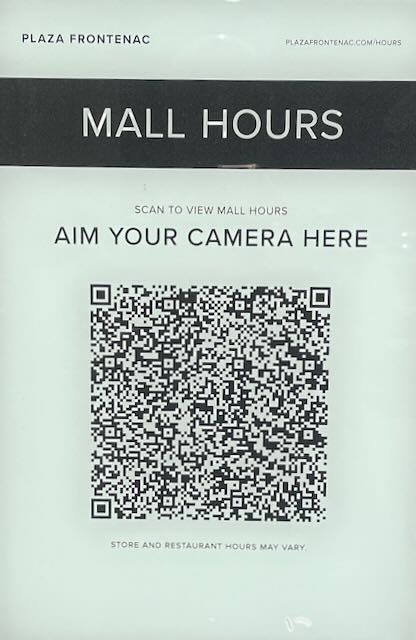When my wife and I went to see “You Hurt My Feelings” (which I reviewed here) over the weekend at the Plaza Frontenac movie theater, we encountered this sign on an entrance door to the mall:

Imagine the time and effort that went into setting up that QR code as well as the results page you’d land on if you used it — instead of just posting the hours the mall is open. By the way, they don’t change much: 10am to 7pm Monday through Saturday and Noon to 6pm Sunday.
How hard is that to fit on a sign in the doorway? But someone in the mall management office must have become obsessed with QR codes and thought this was a brilliant idea. In fact, the public has been expressing its disdain for them for quite awhile.
Restaurants have learned this lesson. They relied on QR codes to provide contactless menus for customers during COVID, when we weren’t supposed to touch anything anyone else had touched (even though the virus wasn’t contracted that way). But using them was so much worse than seeing the food options on a printed menu. The online result was rarely optimized for mobile, so we ended up squinting at small print on our phones, a classic case of a solution designed by people who were not users.
In museums, I’ve seen QR codes replace the text next to painting and sculptures, forcing me to take my phone out and, again, read the information that could have just as easily been printed on a card and posted adjacent to the work of art. If there’s too much info to put on the wall, okay, direct me elsewhere, but most people aren’t going to bother scanning the code to find it.
How about TV commercials that put a QR code up for a couple of seconds and say “scan here for details”? I’m never going to do that. By the time I pick up my phone and point it at my TV — which is all the way across the room, so I’d have to zoom in before the camera even recognized there was a QR code to focus on — the commercial will be over. And I’m not pausing whatever I’m watching to get some promotional mumbo-jumbo or lame upselling attempt from wherever the QR code sends me.
The one use I do like is when the server in a restaurant brings me a check which has a QR code that allows me to pay easily through a third-party app. It’s not distracting, it’s actually helpful and easy to use.
I recently asked a waitress how she knew if customers just walked out without using the code and forking over the funds. She explained the info comes up on the computers they use to handle orders as well as payments. She added that since they’ve started printing the QR code on the check, they’ve seen a drop in people dining and dashing — and her tips have gone up.
I was glad to hear that. And even gladder she didn’t direct me to yet another QR code for the answer.
Mark my words: a genius similar to the one in the mall management office will soon decide that QR codes would be good to use on those signs that tell us about gas, food, and lodging options at highway exits. Imagine the in-car fumbling that would take place at 70mph just to find out if there’s a Burger King nearby.
